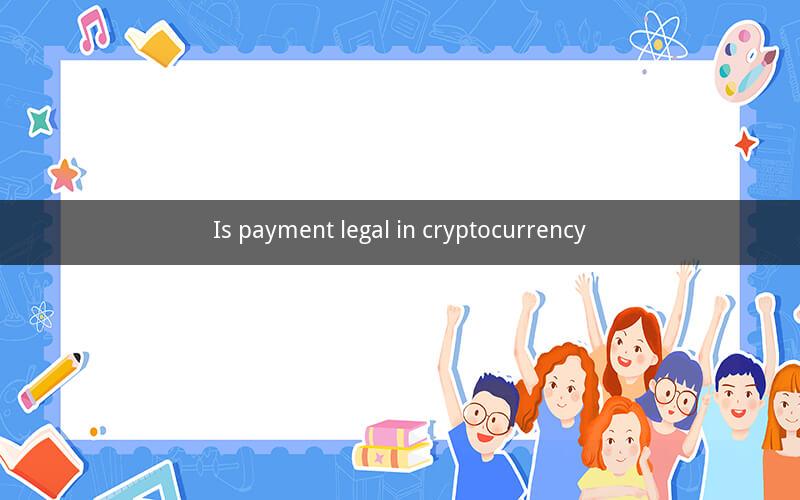
Table of Contents
1. Introduction to Cryptocurrency
2. Understanding Legal Frameworks
3. Cryptocurrency Payment Legality Across Countries
1. United States
2. Europe
3. Asia
4. Africa
5. South America
4. Challenges and Risks of Cryptocurrency Payments
5. Future Outlook and Trends
1. Introduction to Cryptocurrency
Cryptocurrency has revolutionized the way transactions are conducted globally. It operates on the principle of blockchain technology, a decentralized ledger that records all transactions across a network of computers. Unlike traditional fiat currencies, cryptocurrencies are digital or virtual currencies that use cryptography for security.
2. Understanding Legal Frameworks
The legality of cryptocurrency payments varies by country, influenced by the regulatory frameworks in place. Legal frameworks typically address issues such as the recognition of cryptocurrencies as legal tender, the regulation of exchanges, and the taxation of cryptocurrency transactions.
3. Cryptocurrency Payment Legality Across Countries
3.1 United States
In the United States, cryptocurrencies are not considered legal tender, but they are recognized as property. This means that they are subject to taxation, and exchanges must comply with anti-money laundering (AML) and know your customer (KYC) regulations. However, the legality of using cryptocurrencies for payment purposes varies by state.
3.2 Europe
Europe has a diverse approach to cryptocurrency legality. While the European Union does not recognize cryptocurrencies as legal tender, many member states have adopted a permissive stance. For example, Germany recognizes cryptocurrencies as a "means of payment," while France has implemented stricter regulations.
3.3 Asia
Asia's approach to cryptocurrency legality varies significantly. Japan has been one of the most progressive countries, recognizing cryptocurrencies as a legal payment method and regulating exchanges rigorously. In contrast, China has implemented a ban on cryptocurrency transactions and mining, considering them as illegal.
3.4 Africa
In Africa, the legality of cryptocurrency payments is still evolving. While some countries have embraced cryptocurrencies, others remain cautious. South Africa, for instance, has recognized cryptocurrencies as legal, but the regulatory environment is still developing.
3.5 South America
South America's approach to cryptocurrency legality is mixed. Countries like Argentina and Uruguay have been relatively open to cryptocurrencies, while others, like Brazil, have implemented stricter regulations.
4. Challenges and Risks of Cryptocurrency Payments
Despite the growing acceptance of cryptocurrencies, there are several challenges and risks associated with their use for payments:
- Volatility: Cryptocurrencies are known for their price volatility, which can affect the value of transactions.
- Security: The decentralized nature of blockchain technology does not eliminate the risk of hacks and theft.
- Regulatory Uncertainty: The lack of a uniform global regulatory framework can lead to uncertainty and potential legal issues.
- Adoption Hurdles: The widespread adoption of cryptocurrency payments is hindered by a lack of awareness and understanding among consumers.
5. Future Outlook and Trends
The future of cryptocurrency payments appears promising, with several trends emerging:
- Increased Regulation: Governments around the world are likely to continue regulating cryptocurrencies to ensure consumer protection and prevent illegal activities.
- Widespread Adoption: As awareness and understanding of cryptocurrencies grow, their adoption for payments is expected to increase.
- Integration with Traditional Systems: Cryptocurrency payments are likely to be integrated more seamlessly with existing financial systems.
Questions and Answers
1. Question: How does the legality of cryptocurrency payments in the United States differ from that in Europe?
- Answer: The United States recognizes cryptocurrencies as property, subject to taxation and AML/KYC regulations, while Europe has a diverse approach, with some countries like Germany recognizing them as a means of payment.
2. Question: What are the main challenges faced by cryptocurrency payments in Asia?
- Answer: The main challenges include regulatory uncertainty, high volatility, and the need for increased awareness and understanding among consumers.
3. Question: How has the regulatory environment in Africa influenced the adoption of cryptocurrency payments?
- Answer: The regulatory environment in Africa varies, with some countries like South Africa embracing cryptocurrencies, while others remain cautious or implement stricter regulations.
4. Question: What risks are associated with the use of cryptocurrency for payments?
- Answer: The risks include volatility, security concerns, regulatory uncertainty, and adoption hurdles.
5. Question: How is the future outlook for cryptocurrency payments?
- Answer: The future outlook appears promising, with trends indicating increased regulation, widespread adoption, and integration with traditional financial systems.
6. Question: What role do governments play in the regulation of cryptocurrency payments?
- Answer: Governments play a crucial role in regulating cryptocurrency payments to ensure consumer protection, prevent illegal activities, and promote financial stability.
7. Question: How does the legality of cryptocurrency payments affect their adoption?
- Answer: The legality of cryptocurrency payments significantly affects their adoption, as it influences consumer trust and the overall regulatory environment.
8. Question: What are the implications of the volatility of cryptocurrencies for payment transactions?
- Answer: The volatility of cryptocurrencies can lead to unpredictable transaction values, potentially affecting the reliability of cryptocurrency payments.
9. Question: How can security risks be mitigated in cryptocurrency payment systems?
- Answer: Security risks can be mitigated through robust cybersecurity measures, regular audits, and the implementation of best practices in blockchain technology.
10. Question: What is the impact of integration with traditional financial systems on cryptocurrency payments?
- Answer: Integration with traditional financial systems can enhance the credibility and accessibility of cryptocurrency payments, potentially leading to increased adoption.